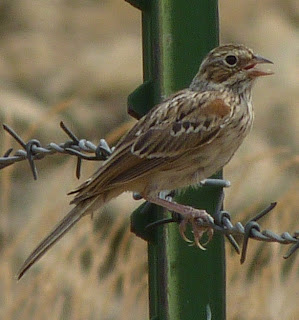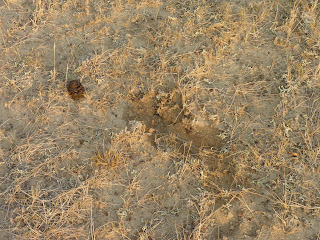Between Meeteetse and Thermopolis, WY, we stopped at the Gooseberry Creek Rest Area; my luck with lifers in such random areas as rest areas and gas station parking lots is well-documented, and we were weren't disappointed at this rest area!
First, I just saw my old friend the Black-billed Magpie:
I also got better looks at Rock Wren; look at this ridiculous beak!
I couldn't believe the schnozz on this guy. While watching him flit around and perch on walls and eat grasshoppers, I noticed a colorful sparrow:
LARK SPARROW! Yes! Lifer! My gosh, what a beautiful bird. He really showed me his field marks, too, making my ID immediate and confident.
I've always wanted to see one of these! I had scored a lifer at a rest stop once again. I kept looking around, being mindful of the many warnings about Prairie Rattlesnakes (eek). I then saw this little guy:
As much as I wanted him to be a Sprague's Pipit, I knew in an instant that he was the cute little Vesper Sparrow. I was happy to get such good pics of him, though, for my lifebirds photo folder. I saw another familiar face:
Eastern Kingbird. Here's one with flaps on full:
I love these birds; still, I was hoping to get a Western Kingbird on this trip, something that hadn't happened yet. I noted that Eastern, however, is the only kingbird with a white breast; the rest have yellow breast feathers. You'd think I would've realized this fact earlier, seeing as how I've seen Cassin's, Tropical, Couch's, and Eastern, but this was the first time it dawned on me that (duh) all of them have the yellow except our Eastern. And all the yellow-breasted ones are western/southwestern birds. Interesting.
After Thermopolis, we drove on through Wind River Canyon, a beautiful drive:
As I snapped this photo, I noticed this little sign:
That's right: they have signs pointing out their geologic formations and how old they are. TOTALLY COOL! Check out these Cambrian formations:
Just think of it; these cliffs were formed BEFORE the dinosaurs, before the continents as we know them, when the absolute earliest lifeforms scuttled around the seafloor! I was pretty much blown away.
I came back to myself, though, when I saw these:
Common Mergansers, hanging out in the Wind River. Cool. Also present:
Looks like a Double-crested Cormorant on the right, as least as well as I could tell. I can't imagine there would be any other corms here. But what about the one on the left? I know they have Anhinga here; perhaps that's an Anhinga? Not a lifer, but amazing! I'd only ever seen them in Texas. He is so much smaller than the DCCO, and his beak is more like an Anhinga. Tough to tell from this blurry pic, taken from about 100-150 yards above.
Sometimes, AB's crazy-mad bird skillz amaze me. She was driving, going around 80mph, and she stood on the brakes and said, "BIG BIRD!" We whipped around and found a Golden Eagle, perched majestically on a rocky cliff on the roadside! Unfortunately, he took off before I could snap a photo, so this was the only evidence:
He was HUGE. I'd only seen a Golden once before, at a hawk watch, so I had no idea how big they are in person, especially at like 20 yards. I wish I'd gotten him perched, but at least I got to see him in the bins for a few seconds to confirm the ID and appreciate his golden beauty.
Later, AB showed her skillz again when she saw this raptor perched upon an old tin barn:
He never turned around to face us, but you can kinda see how he danced a little with his wings up, floating and then landing and then dancing some more. I swear, my raptor ID skills stink out loud. I'm confused and more than a little gunshy on IDing this as anything other than a red-tail. I am certain it's a buteo, so my options are limited. (Unless I'm wrong about that!) Note the dark brown tail with the thin strip of white on the tips. That's no red-tail tail, right? (Work with me here; help me think it through.) Okay -- even Harlan's, the dark-morph variant of Red-tailed Hawk, doesn't appear to have the white tail tips, and his tail is supposed to be a warm reddish brown.This guy's is a dark brown.
Okay--I'm thinking it's either a Rough-legged Hawk or something else. But rough-legs have a white tail with a black band. Plus rough-legs winter in Wyoming, and it was only early August. This isn't a rough-leg, right?
On to Swainson's but the face is wrong. Swainson's would have white above and below the beak.
WHAT THE HECK!??? Help! I bet it's just a freaking color variant of Red-tailed, and I'm over-thinking. Or under-thinking. Or focusing on too few details. I don't know! I'm not looking for a lifer here; I just want to improve my raptor skills. They get rusty so freakin' fast. I've been so focused on songbirds that raptors are just not that important for me. Still, they frustrate me!
Hmph. Speaking of songbirds, there was a little yellow-colored warbler there as well:
This was the only photo I got before he flitted off, completely oblivious to the raptor. No telling what he was, though there are several possibilities. This was the middle of the Wyoming plains, no boreal habitat for miles.
Finally, we arrived -- with no signs or other notice -- in the Thunder Basin National Grasslands. I was expecting something like the Pawnee National Grasslands, uninhabited and undeveloped: pure prairie. I didn't get that. It was a lot of ranches, oil drilling, and coal mining. I was really disappointed.
There were TONS of Pronghorned Antelope:
And at one point, after hanging a right from Hwy 59 northbound onto Hwy 450 east toward Newcastle (our destination for the night), I saw a sign and a dirt road entrance for the grasslands, so we drove about 200 yards in, away from the road, and I got out and looked around.
My expectations were ridiculously high; for some reason, I thought I was going to see a big sign that said, "Burrowing Owl: 30 yards east, hang a right at the pronghorn, can't miss it!" What I saw, however, was miles of prairie and small hills, always interrupted by mines or drilling or ranch houses. I was so bummed out. It was just so developed.
Still, I did see this little Horned Lark:
for about a second before he flew off and disappeared. You know how tricky these little guys are. You hear their peeping, see a little flash, and then NOTHING. I was lucky to get this crappy photo.
I also saw this:
Some pronghorn had a bad day. Coyotes? Wolves? People? Who knows.
Perhaps the most exciting thing I saw was this:
Minutes before, someone had taken a potty break! The ground was still obviously wet, and in this dry climate, it wouldn't have lasted more than ten or fifteen minutes, tops.
The unspoiled part:
Game trails, either pronghorns or deer or sheep (lots of ranching here):



























3 comments:
I think, if you pick the right roads, you can coast all the way from the Continental divide to Chicago!
Rabbits' Guy--that may be true; we might've been on just the right roads. Until we hit Indiana/Illinois/Ohio. BO-RING.
Your mystery raptor is a Young Swainson's Hawk, note the dark breast and flight feathers on the underside of the wings. Also those flight feathers have the typical grey look Swainson's have. Also, it has a small headlight above it's beak. This looks like a dark or intermediate morph. I hope that helps!
Post a Comment